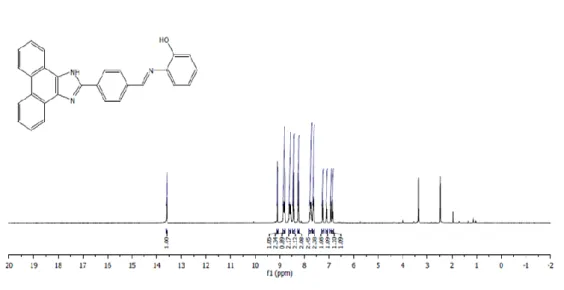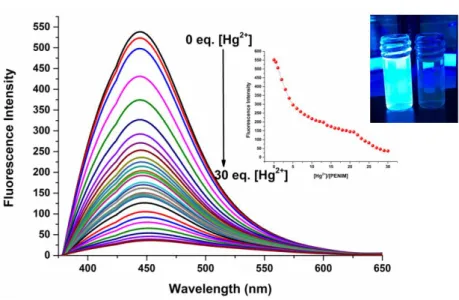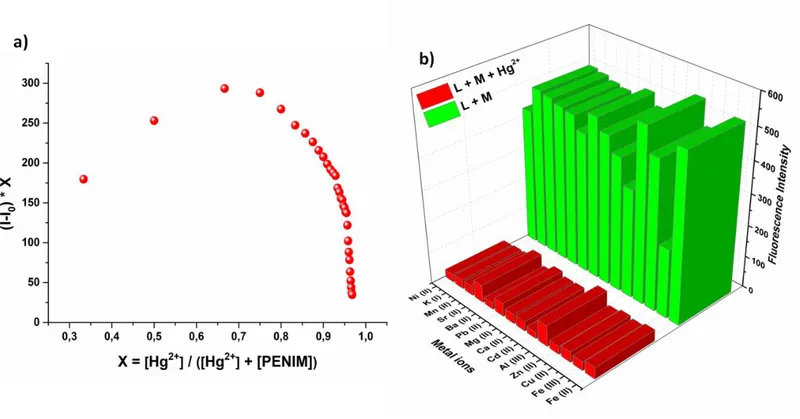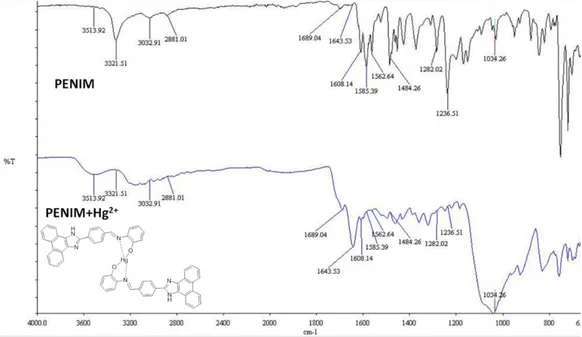Sayı 17, S. 483-490, Aralık 2019
© Telif hakkı EJOSAT’a aittir
Araştırma Makalesi
www.ejosat.com ISSN:2148-2683No. 17, pp. 483-490, December 2019
Copyright © 2019 EJOSAT
Research Article
A Turn OFF Fluorescent Probe For Selective Detection Of Hg
2+
Ions
Duygu Aydin
11 Karamanoglu Mehmetbey University, Kamil Ozdag Science Faculty, Department of Chemistry, Karaman, 70100 Turkey, (ORCID:
0000-0003-0436-1869)
(İlk Geliş Tarihi 1 Ekim 2019 ve Kabul Tarihi 27 Ekim 2019) (DOI: 10.31590/ejosat.634119)
REFERENCE: Aydin, D. (2018). A Turn Off Fluorescent Probe for Selective Detection of Hg2+ Ions. European Journal of Science and Technology, (17), 483-490.
Abstract
In this study, we prepared a novel fluorescent chemosensor containing an imidazole molecule and the chemosensor characterized utilizing 1H-NMR, 13C-NMR spectroscopy, FT-IR spectrometer and elemental analyzer. Prepared sensor was utilized as an effectively selective and a fastly responsive chemical fluorescent sensor for ‘’turn off’’ determination of mercury (II) ions in EtOH. A clear complex between 2-((4-(1H-phenanthro[9,10-d] imidazol-2-yl)benzylidene)amino) phenol (PENIM) and Hg+ ions was determined and calculated employing the Job’s method and also the limit of detection value was found to be 2.1 nM on the basis of 3σ/k. Furthermore, the sensor-Hg2+ displayed and reversible property for mercapto containing cysteine molecules. Also, the fluorescence enhancement and quenching studies were supported by computational experiments based on the density functional theory (DFT) calculations.
Keywords: Fluorescence sensor, Mercury ions.
Öz
Bu çalışmada imidazol içeren yeni bir floresan sensör sentezlenmiş ve sentezlenen sensörün karakterizasyonu 1H-NMR, 13C-NMR spektroskopisi, FT-IR spektroskopisi ve elemental analiz cihazı kullanılarak yapılmıştır. Hazırlanan sensör etanol içerisinde civa iyonlarına hem hızlı hem de seçici olarak floresanı söndürerek cevap vermiştir. Sentezlenen 2-((4-(1H-Fenantreimidazol [9,10-d] imidazol-2-)benziliden)amino) fenol (PENIM) and Hg+ iyonları arasında kompleksleşme gerçekleştirilmiş ve bu komplesleşme JOB metodu kullanılarak da kompleksleşme oranı teorik olarak hesaplanmıştır. Sentezlenen probun deteksiyon limiti 3σ/k formülü kullanılarak 2.1 nM olarak tespit edilmiştir. Ayrıca, elde edilen civa (II)-PENIM, merkapto molekülü içeren sistein amino asidine karşı tersinir olarak cevap vermiştir. PENIM molekülünün civa iyonlarına karşı cevap vermesinin sonucu olarak floresan şiddetinin artırılması ve söndürülmesi ile ilgili çalışma, yoğun fonksiyonel hesaplama(DFT) yapılarak teorik olarak desteklenmiştir.
Anahtar Kelimeler: Floresan sensör, Civa iyonları
1. Introduction
During the past decade, development of practical chemosensors has been taken attention of researchers since they allow the selective and sensitive detection of heavy metal ions causing serious environmental disasters and health problems. Among these metal ions, mercury ions and most of their compounds exist in water, soil, and food. Even in small concentrations, they are extremely poisonous neurological toxins and the most ubiquitous pollutants in ecosystem. The human body may receive mercury ions through contaminated natural water which is a major source of mercury ions and skin contact to mercury containing natural and anthropogenic sources. The accumulation of mercury ions in the body can cause a number of severe permanent health problems for example brain damage, and various cognitive and motion disorders, mitosis impairment, coronary heart disease and kidney failure(J. F. Chen et al., 2017; Jiao, Zhang, & Zhou, 2016; G. Li, Ma, Liu, Fan, & Pu, 2017; Q. Li et al., 2016). The Environmental Protection Agency (EPA) and The World Health Organization (WHO) have reported that the maximum allowable concentration for mercury (II) in drinking water is 2.0 and 6.0 ppb, respectively (M. Li, Zhou, Ding, Guo, & Wu, 2013).
yl)benzaldehyde (PENIM) for the determination of mercury (II) ions in ethanol. Fabricated sensor was analyzed by 1H-NMR, 13 C-NMR, ATR–FTIR spectroscopy and elemental analyzer. It showed a remarkable fluorescence enhancement for mercury (II) the detection in solution with high sensitivity and selectivity. Therefore, fabricated sensor could be utilized as a fluorescence sensor for analyzing of mercury (II) in solutions.
2. Materials and Methos
2.1. General Information
2-hydroxy anyline, terephtalaldehyde, amoniumacetate, 9,10-phenanthroquinone, ammonium acetate, other used reagents and all solvents were obtained from commercial suppliers and they were employed without further purification. Perchlorate salts of metal ions were utilized. FT-IR spectroscopy and NMR spectra were collected employing a Perkin Agilent Cary Eclipse spectrometer and a Varian 400 MHz instrument, respectively. Elemental analysis results for PENIM were obtained by using a Leco CHNS 932 instrument. Fluorescent spectra were taken using on a Perkin Agilent Cary Eclipse spectrometer.
2.2. Synthesis of 4-(1H-phenanthro[9,10-d]imidazol-2-yl)benzaldehyde (PEMA)
The synthesis of 4-(1H-phenanthro[9,10-d]imidazol-2-yl)benzaldehyde (PEMA) was carried out according to reported previously literature (Lin, Long, Yuan, Cao, Chen&Tan, 2008).
2.3. Synthesis of 2-((4-(1H-phenanthro[9,10-d]imidazol-2-yl)benzylidene)amino)phenol (PENIM)
To synthesize the ligand, ((4-(1H-phenanthro[9,10-d]imidazol-yl)benzylidene)amino) phenol (PENIM) (0.5 g, 1.55 mmol) and 2-hydroxy anyline (0.169 g, 1.55 mmol) were added into a round-bottom flask and dissolved in absolute ethanol (10 mL) and reaction was refluxed for 12 h under nitrogen atmosphere. Afterwards, precipitate was filtered and washed with excess EtOH for removing unreacted species. The precipitate was dried in vacuo. Yield: 60%. Anal. Calcd. for C28H19N3O (Mw: 413.47): requires C, 81.97; H, 4.38; N, 8.69 % Found: C, 81.21; H, 4.45; N, 8.95%. 1H NMR (400 MHz, d
6-DMSO): δ 6.70 (t, 1H, ArH), 6.90 (d, 1H, ArH), 7.22 (t, 1H, ArH), 7.40 (d, 1H, ArH), 7.60 (m, 2H, ArH), 7.70 (m, 2H, ArH), 8.32 (d, 2H, ArH), 8.45 (d, 2H, ArH), 8.62 (m, 2H, ArH), 9.06 (m, 2H, ArH), 8.89 (s, 1H, CHN), 9.21 (s, 1H, OH), 13.53 (s, 1H, NH). 13C NMR (100 MHz, d
6-DMSO): δ 152.51, 151.99, 140.57, 137.78, 135.06, 134.61, 131.70, 131.50, 130.68, 128.24, 127.43, 127.21, 125.98, 125.86, 125.47, 125.05, 125.01, 124.52, 124.45, 124.34, 124.29, 120.98, 120.29, 116.76 (Fig1 and 2).
Fig. 1. 1H-NMR spectrum of PENIM in DMSO-d 6.
Fig. 2. 13C-NMR spectrum of PENIM in DMSO-d 6.
2.4. The procedures of Hg (II) determination
Initially, 10.0 mM ligand solution was dissolved in dimethylsulfoxide (DMSO) and diluted with EtOH and so the concentration of prepared ligand was obtained as 1.0 μM. 3 mL of solution was added to a cuvette to evaluate detection of Hg2+. Afterwards, probe solution (1.0 μM) was mixed to obtain homogenous mixture. Then, the fluorescence measurements of probe solutions was measured in the presence of other cation ions utilizing λex=364 nm, λem=442 nm and slit widhts=10 nm, 10 nm.
3. Results and Discussion
3.1. Synthesize
To synthesize our designed sensor (PENIM), we first prepared PEMA according to previous literature. Afterwards, PEMA was reacted with hydroxy anyline using reflux system in dry EtOH at high yield. The prepared compound was analyzed utilizing 1 H-NMR, 13C-NMR, FT-IR spectroscopy and elemental analyzer. The general procedure for synthesis is presented in Scheme 1.
Scheme 1. Synthesis routes of PEMA and PENIM.
3.2. Fluorescence studies
The fluorescence ability of the prepared PENIM (1.0 µM) in EtOH was evaluated in the presence of 10.0 equiv of a series of metal ions (K+, Mg2+, Ni2+, Ba2+, Mn2+, Sr2+, Fe2+, Fe3+, Cu2+, Zn2+, Cd3+, Hg2+, Al3+, Ca2+ and Pb2+) employing fluorescence spectroscopy. Initially, the probe in EtOH controlled and displayed the highest fluorescence intensity at 442 nm in the absence of metal ions (Fig 3a). Afterwards, as depicted in Fig 3b, addition of Hg2+ to prepared PENIM in EtOH (1.0 µM) leads to the fluorescence complete quenching of emission band at 442 nm, but none of the other metal ions except Hg2+ displayed a remarkable change of the fluorescence intensity of fabricated probe at 442 nm. Furthermore, the fluorescence intensity of the designed sensor was tested in various solvents, including N,N-dimethyl formamide (DMF), ethanol (EtOH) and water, compared with acetonitrile (CH3CN) (Fig. 3b). Consequently, fabricated probe displayed the strong interaction with Hg (II) ions compared to other metal ions and this is as a result of the formation of the stable chelation between PENIM and Hg2+ through the phenolic oxygen and N atoms.
Figure 4. The fluorescence spectrum of PENIM with of increasing concentration of Hg2+ in EtOH (ex= 364 nm).
The binding constant of PENIM with mercury (II) has been determined employing Benesi–Hildebrand plot based on the fluorescence titration data and calculated to be 1.119×105 M-1 (Fig. 5a). Moreover, according to a plot of the concentration of mercury ions versus fluorescence intensity at 442 nm, the detection limit (LOD) of for the detection of PENIM for Hg2+ based on 3σ/k equation was found to be 2.1 nM and this value was much lower than the maximum allowed levels of mercury (II) in drinking water of U.S. EPA (2.0 ppm) and WHO (6.0 ppm) (Fig. 5b)(M. Li et al., 2013). To examine the binding stoichiometry between PENIM and Hg2+, the Job’s plot was conducted and 2:1 stoichiometric complexation between PENIM and Hg2+ was obtained as a result of the maximum relative fluorescence intensity was around 0.66 (Fig. 6a).
Figure 5. (a) Benesi–Hildebrand plots from fluorometric titration data of PENIM (1.0 μM) with Hg2+ and (b) The plot of emission intensities of PENIM at 412 nm versus with various Hg2+ concentrations.
The effects of other cations on the interaction of PENIM (1.0 µM) in EtOH with mercury (II) ions were examined by comparison experiments. These experiments were carried out by Hg (II) ions in the presence of 10.0 equiv of other metal ions. Other metal ions, except for Fe3+ and Al3+, did not interfere with mercury (II) ions(Fig. 6b). It appears that PENIM is an effective fluorescence sensor for the detection of Hg2+ cations, even in the presence of many other metals.
Figure 6. (a) Job’s plot study of PENIM (1.0 μM) with Hg2+ and (b) competition studies of PENIM with Hg2+ in the presence of
various metal ions at 412 nm in EtOH.
To confirm the optimized structure of the complexation, the density functional theory (DFT) calculations for obtaining computational experiments were carried out with B3LYP/6-31G(d) basis sets utilizing a suite of Gaussian 09 programs. The gaps of bands between HOMO (highest occupied molecular orbital) and LUMO (highest occupied molecular orbital) of PENIM and PENIM-Hg2+ were found to be 3.4 eV and 2.76 eV respectively. These results revealed that the interaction between PENIM and Hg2+decreases the HOMO-LUMO energy gap of the complex and so the stabilized complex formation between PENIM and Hg2+ was obtained (Fig. 7).
In addition, PENIM and PENIM-Hg2+ were characterized with FT-IR spectroscopy measurements. The band at 3321 cm-1 is attributed to the characteristic vibration of the phenolic -OH and this band conforming PENIM-Hg2+ formation via coordination between -OH and Hg2+ disappears. Also, a band at 1585 cm-1 proves the vibration of -CH bonding of shift base and shifts to higher frequency to 1643 cm-1. The above results display that the complexation PENIM-Hg2+ formed via CHN group of shift base and OH group of PENIM (Fig 8).
Figure 8. FT-IR spectrum of PENIM and PENIM-Hg2+
Response time is a very important parameter for various applications and real time monitoring, so low response time has advantages. Therefore, the binding process of mercury (II) ions to prepared PENIM was investigated to understand response time of this complexation process as shown in Fig. 9a. Fluorescence intensity of fabricated PENIM-Hg2+ remains constant within 30s after the addition of Hg2+ to the PENIM solution (1.0 µM) in EtOH.
Reversibility of a probe plays critical roles in judging its chances for practical applications. The reversibility of the Hg2+ complexation with the PENIM employed reversible property allowed the detecting of various amounts of thiol containing cysteine amino acid. As shown in Fig 9b, when thiol containing cysteine was added to the Hg2+ complexation with the PENIM, the fluorescence intensity raised. However, upon adding of the Hg2+ solution again, it was observed that the intensity decreased again. These results clearly demonstrated that the reversibility of the Hg2+ complexation with the probe can be easily regenerated for repeated use and gives a chance for utilizing practical applications.
Chen, J. F., Han, B. B., Ma, J. F., Liu, X., Yang, Q. Y., Lin, Q., Wei, T. B. (2017). Pillar[5]arene-based fluorescent polymer for selective detection and removal of mercury ions. RSC Advances, 7(75), 47709–47714. https://doi.org/10.1039/c7ra10326c Chen, L., Yang, L., Li, H., Gao, Y., Deng, D., Wu, Y., & Ma, L. J. (2011). Tridentate lysine-based fluorescent sensor for Hg(II) in
aqueous solution. Inorganic Chemistry, 50(20), 10028–10032. https://doi.org/10.1021/ic200790g
Guo, C., & Irudayaraj, J. (2011). Fluorescent Ag clusters via a protein-directed approach as a Hg(II) ion sensor. Analytical Chemistry, 83(8), 2883–2889. https://doi.org/10.1021/ac1032403
Han, B., Yuan, J., & Wang, E. (2009). Sensitive and selective sensor for biothiols in the cell based on the recovered fluorescence of the CdTe quantum dots-Hg(II) system. Analytical Chemistry, 81(13), 5569–5573. https://doi.org/10.1021/ac900769h
Jiao, Y., Zhang, L., & Zhou, P. (2016). A rhodamine B-based fluorescent sensor toward highly selective mercury (II) ions detection. Talanta, 150, 14–19. https://doi.org/10.1016/j.talanta.2015.11.065
Karuk Elmas, Ş. N., & Yilmaz, I. (2018). A Turn off-on Fluorescent Chemosensor for Sequential Determination of Mercury and Biothiols. Journal of Fluorescence, 28(6), 1451–1458. https://doi.org/10.1007/s10895-018-2320-6
Li, G., Ma, L., Liu, G., Fan, C., & Pu, S. (2017). A diarylethene-based “on-off-on” fluorescence sensor for the sequential recognition of mercury and cysteine. RSC Advances, 7(33), 20591–20596. https://doi.org/10.1039/c6ra27773j
Li, M., Zhou, X., Ding, W., Guo, S., & Wu, N. (2013). Fluorescent aptamer-functionalized graphene oxide biosensor for label-free detection of mercury(II). Biosensors and Bioelectronics, 41(1), 889–893. https://doi.org/10.1016/j.bios.2012.09.060
Li, Q., Wang, C., Tan, H., Tang, G., Gao, J., & Chen, C. H. (2016). A turn on fluorescent sensor based on lanthanide coordination polymer nanoparticles for the detection of mercury(II) in biological fluids. RSC Advances, 6(22), 17811–17817. https://doi.org/10.1039/c5ra26849d
Lin W., Long L., Yuan L., Cao Z., Chen B., and Tan W., (2008). A Ratiometric Fluorescent Probe for Cysteine and Homocysteine Displaying a Large Emission Shift, Org. Lett., 10(24), 5577-5580. https://doi.org/10.1021/ol802436j.
Taki, M., Akaoka, K., Iyoshi, S., & Yamamoto, Y. (2012). Rosamine-based fluorescent sensor with femtomolar affinity for the reversible detection of a mercury ion. Inorganic Chemistry, 51(24), 13075–13077. https://doi.org/10.1021/ic301822r.



